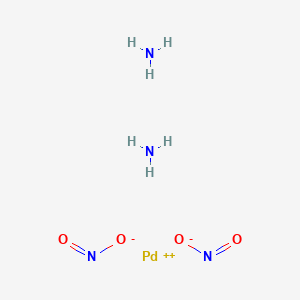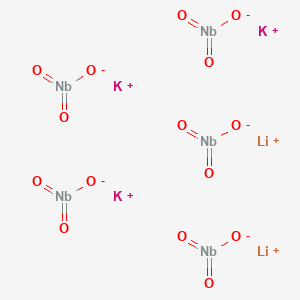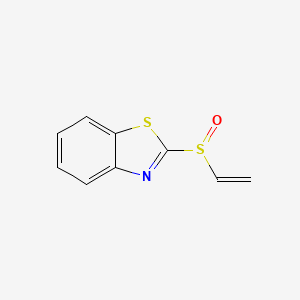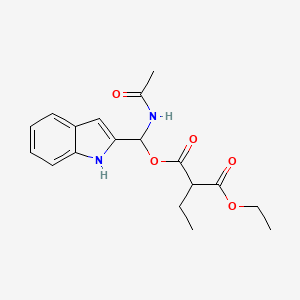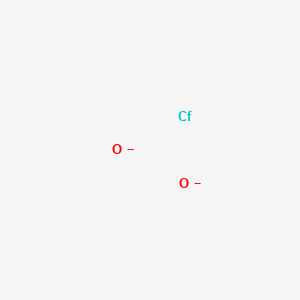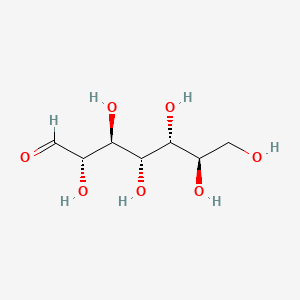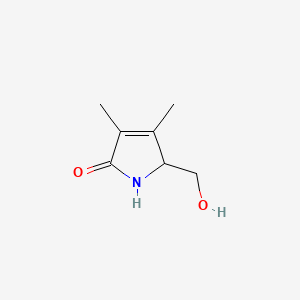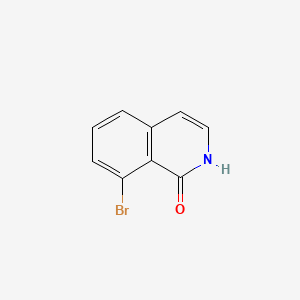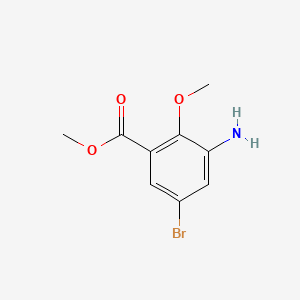
Calcium-46
Overview
Description
Calcium-46 is a stable isotope of calcium with an atomic number of 20 and a mass number of 46. It is one of the less abundant isotopes of calcium, constituting about 0.004% of natural calcium . This compound is notable for its stability and its role in various scientific research applications, particularly in the fields of geology, biology, and medicine.
Scientific Research Applications
Calcium-46 has a wide range of applications in scientific research:
Mechanism of Action
Safety and Hazards
Future Directions
Preparation Methods
Synthetic Routes and Reaction Conditions: Calcium-46 can be produced through the neutron activation of calcium-45 or by the separation of isotopes using mass spectrometry techniques . The process involves irradiating calcium-45 with neutrons, which converts it into this compound.
Industrial Production Methods: Industrial production of this compound typically involves the use of high-purity calcium sources and advanced separation techniques such as thermal ionization mass spectrometry (TIMS) and accelerator mass spectrometry (AMS) . These methods ensure the precise separation and enrichment of this compound from other isotopes.
Chemical Reactions Analysis
Types of Reactions: Calcium-46, like other calcium isotopes, undergoes various chemical reactions, including:
Oxidation: Reacts with oxygen to form calcium oxide (CaO).
Reduction: Can be reduced from calcium compounds to elemental calcium.
Substitution: Participates in substitution reactions with halogens to form calcium halides (e.g., calcium chloride, calcium fluoride).
Common Reagents and Conditions:
Oxidation: Requires oxygen or air, typically at elevated temperatures.
Reduction: Often involves reducing agents such as hydrogen or carbon at high temperatures.
Substitution: Reacts with halogens like chlorine, fluorine, bromine, and iodine under controlled conditions.
Major Products:
Oxidation: Calcium oxide (CaO)
Reduction: Elemental calcium (Ca)
Substitution: Calcium halides (e.g., calcium chloride (CaCl2), calcium fluoride (CaF2))
Comparison with Similar Compounds
Calcium-40: The most abundant
Properties
IUPAC Name |
calcium-46 | |
|---|---|---|
| Source | PubChem | |
| URL | https://pubchem.ncbi.nlm.nih.gov | |
| Description | Data deposited in or computed by PubChem | |
InChI |
InChI=1S/Ca/i1+6 | |
| Source | PubChem | |
| URL | https://pubchem.ncbi.nlm.nih.gov | |
| Description | Data deposited in or computed by PubChem | |
InChI Key |
OYPRJOBELJOOCE-LZFNBGRKSA-N | |
| Source | PubChem | |
| URL | https://pubchem.ncbi.nlm.nih.gov | |
| Description | Data deposited in or computed by PubChem | |
Canonical SMILES |
[Ca] | |
| Source | PubChem | |
| URL | https://pubchem.ncbi.nlm.nih.gov | |
| Description | Data deposited in or computed by PubChem | |
Isomeric SMILES |
[46Ca] | |
| Source | PubChem | |
| URL | https://pubchem.ncbi.nlm.nih.gov | |
| Description | Data deposited in or computed by PubChem | |
Molecular Formula |
Ca | |
| Source | PubChem | |
| URL | https://pubchem.ncbi.nlm.nih.gov | |
| Description | Data deposited in or computed by PubChem | |
Molecular Weight |
45.95369 g/mol | |
| Source | PubChem | |
| URL | https://pubchem.ncbi.nlm.nih.gov | |
| Description | Data deposited in or computed by PubChem | |
CAS No. |
13981-77-6 | |
| Record name | Calcium, isotope of mass 46 | |
| Source | ChemIDplus | |
| URL | https://pubchem.ncbi.nlm.nih.gov/substance/?source=chemidplus&sourceid=0013981776 | |
| Description | ChemIDplus is a free, web search system that provides access to the structure and nomenclature authority files used for the identification of chemical substances cited in National Library of Medicine (NLM) databases, including the TOXNET system. | |
Synthesis routes and methods I
Procedure details





Synthesis routes and methods II
Procedure details






Synthesis routes and methods III
Procedure details
















Synthesis routes and methods IV
Procedure details









Disclaimer and Information on In-Vitro Research Products
Please be aware that all articles and product information presented on BenchChem are intended solely for informational purposes. The products available for purchase on BenchChem are specifically designed for in-vitro studies, which are conducted outside of living organisms. In-vitro studies, derived from the Latin term "in glass," involve experiments performed in controlled laboratory settings using cells or tissues. It is important to note that these products are not categorized as medicines or drugs, and they have not received approval from the FDA for the prevention, treatment, or cure of any medical condition, ailment, or disease. We must emphasize that any form of bodily introduction of these products into humans or animals is strictly prohibited by law. It is essential to adhere to these guidelines to ensure compliance with legal and ethical standards in research and experimentation.


